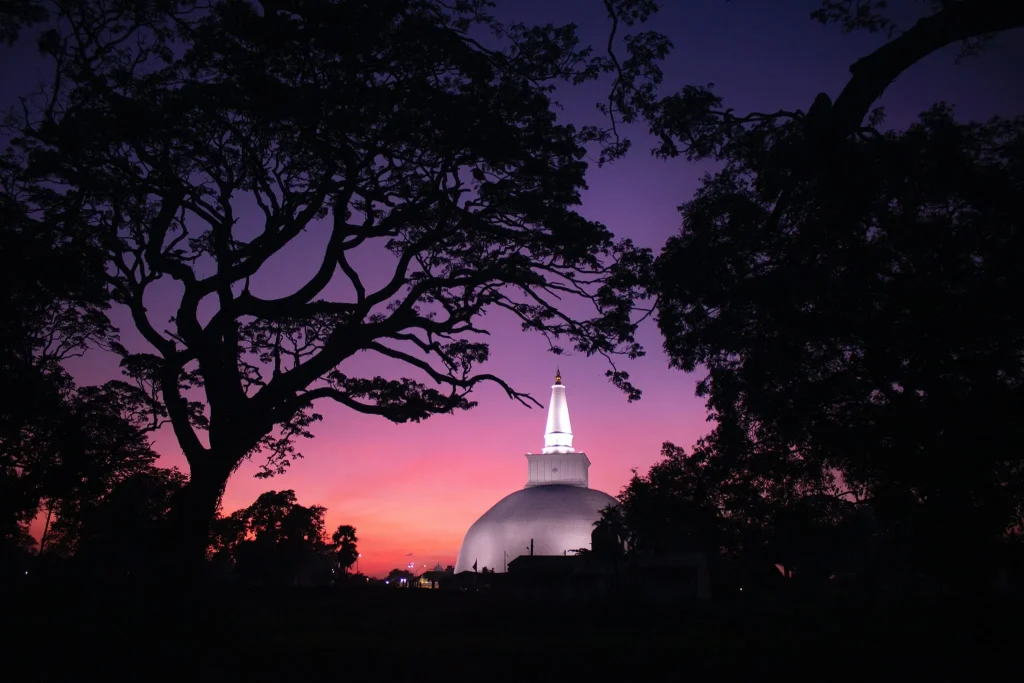Ruwanweli Maha Seya: A Cultural Icon of Sri Lanka
Nestling amidst Anuradhapura’s ancient bosom, Sri Lanka, the Ruwanweli Maha Seya, colloquially termed the Grand Stupa, is an enduring luminary of chronicles and sanctity. Originating from the luminous era of the 2nd century BC, under the eminent dominion of King Dutugemunu, its essence extends beyond mere architectural splendor.
The building, deviating from its sacred resonance, reveals bygone Sri Lankan artisanship. Each rock tells a story of intense dedication, fantastic talent, and an inherent sense of cultural valor. The Ruwanweli Maha Seya is more than a monument. It is a loud reverberation of a nation’s past mixed with unflinching dedication and age-old rituals.
Historical Overview of Ruwanweliseya
Origin and Significance
The Ruwanweli Maha Seya, also known as the Great Stupa, stands tall in Anuradhapura, Sri Lanka. Its history can be traced back to the 2nd century BC, during the reign of King Dutugemunu. Ever wonder why it’s so revered? It symbolizes the country’s rich Buddhist heritage. It serves as a testament to the architectural prowess of ancient Sri Lankan builders.
Architectural Grandeur
Think of it as a grand castle but for spiritual purposes. It is towering at 338 feet. This bubble-shaped stupa was once among the tallest structures of the ancient world. Without today’s machinery, how did they build such a colossal monument?
Cultural Significance of Ruwanwelisaya

Symbol of Buddhist Pride
Sri Lanka, with its deep-rooted Buddhist traditions, sees the Ruwanweli Maha Seya as a monumental emblem of faith. It’s not just a building; it’s a testament to the island’s deep commitment to the teachings of Buddha.
Impact on Sri Lankan Identity
Every Sri Lankan, irrespective of their faith, recognizes the stupa as a national icon. It’s like the Eiffel Tower to the French but infused with deep spiritual meaning.
Features and Attractions
The Relics Inside of Ruwanwali Maha Saya
Legend has it that the stupa houses a relic of Lord Buddha, making it a significant pilgrimage site. Imagine having a piece of history right beneath your feet!
The Stupa’s Design: From afar, its white resplendent dome gleams under the sun. Its design is not just about aesthetics; each element has a symbolic meaning rooted in Buddhist cosmology, from its spire to its base.
Surrounding Monasteries
The Ruwanweli Maha Seya isn’t a standalone marvel. Around it, monasteries with ancient murals and sculptures give visitors a holistic view of the era gone by.
The Restoration Efforts

Past Renovations
This timeless relic faced natural calamities and invasions over the centuries. Yet, each time, it rose from the ashes, thanks to the relentless efforts of rulers and the public. Remember the tale of the phoenix? The stupa’s resilience is quite akin to that!
Modern-Day Preservation
Today, various organizations and the Sri Lankan government ensure that the stupa stands tall for future generations. After all, wouldn’t it be a tragedy if our kids only read about it in books?
Visiting the Ruwanweli Maha Seya
Best Times to Visit: While Sri Lanka is a tropical paradise year-round, visiting during Vesak, a significant Buddhist festival, is magical. The stupa, illuminated with thousands of lanterns, paints a celestial picture.
Tips for Tourists
Respect the Culture: As you enter this sacred space, dress modestly and remove your shoes. After all, when in Rome, do as the Romans do, right?
Guided Tours: To truly appreciate its history, consider hiring a local guide. Think of them as the bridge between the past and the present, narrating tales that aren’t in guidebooks.
